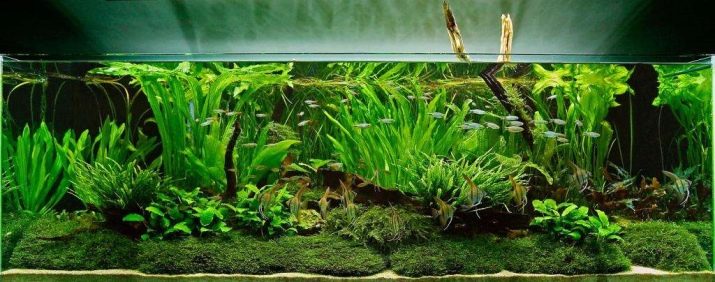How to soften the water in an aquarium and how to make it hard?

An aquarium is an artificial water house for your beloved pets. In order for them to be in a comfortable environment, conditions close to ideal should be maintained. This is necessary to keep fish, algae and other aquarium inhabitants healthy and in top shape.
It is necessary to comply with certain requirements, which include proper lighting, as well as filtration, temperature, water purity, feeding regime. Do not forget about such an important point as the hardness of the water in the aquarium.


What is water hardness?
The term "water hardness" refers to the natural and unnatural features of water, which are due to the presence in it in a dissolved state of mineral salts of alkaline earth metals. They are called hardness salts.
The hardness of the water is influenced by the salts of calcium (Ca) and magnesium (Mg).
In the event that a large amount of these substances is present, then the water is considered hard. If there are few of these elements in the water, then, accordingly, the liquid is considered to be of medium hardness or soft.

Views
There are several units for measuring water hardness. Among aquarists, it is customary to use the German designation dH.
There are also several types of hardness.
- General. The concentration in water of the salts of the above-mentioned alkaline earth metals is called total hardness (gH). It can be permanent (stable) and temporary (non-permanent). Simply put, the total, that is, the total rigidity, is the combination of the first and the second.
- Carbonate. This rigidity is temporary. It occurs when hydrocarbonates (HCO3) are concentrated in water.It can be removed by boiling. If a person takes hard water and boils it for some time, then scale will form on the dishes - this will be a precipitate of carbonates. For example, it can be both calcium bicarbonate (CaHCO3) and magnesium (MgHCO3). This hardness is considered the most important for aquarists. Variable hardness is indicated by the abbreviation kH.
- Non-carbonate. The persistent hardness is due to the presence of strong acid salts in the water, such as hydrochloric acid (HCl) or sulfuric acid (H2SO4). It is called permanent (irreparable, non-carbonate) because measures that can be applied to eliminate temporary hardness (boiling or freezing) will not work in this case. For example, if a person boils or freezes water with a large amount of salts, then they will not precipitate, as they are formed by salts of strong acids.

Influence on the inhabitants of the aquarium
The hardness of the water in the tank has a tremendous effect on the development of fish, other inhabitants and vegetation. Their acclimatization depends on changes in the hardness of the liquid.
For the normal well-being of the inhabitants of the aquarium, water is required, the hardness of which ranges from 3 to 15 degrees.

Effects on fish
Combination of calcium and magnesium salts in water is of great importance for the inhabitants of the underwater world:
- forms and strengthens the skeleton of fish;
- strengthens the shell and shell of molluscs and various crustaceans;
- creates conditions for breeding and improves the habitat.
If these salts are not enough, then the fish will be weak, moreover, their development will slow down.


How do aquarium plants react?
Algae do not like hard water, because the higher the water hardness, the worse the algae grow.
At a high concentration (above 33 degrees), no plants grow except for Cryptocoryne.

How to check the level?
To measure the hardness level of a liquid in your aquarium at home, there are several ways.
Special devices
Use special devices, for example, a device for determining the purity of water TDS (salt meter). It is a device that measures the accumulation of impurities in a liquid.
Such a device works by creating an electric field in the water. It is very easy to calculate all additives in it, not just salts. To measure the amount of chemicals, you need to take one liter of water from the aquarium and lower it with a salt meter. After a few seconds, it will give the measured value in milligrams.

Advantages:
- ease of use;
- instant calculation of impurities;
- practicality in use and storage;
- low cost.
Disadvantages:
- the need to replace batteries;
- approximate measurement accuracy;
- short service life (from 1 to 2 years).


Using paper test strips
Rapid tests are readily available. To find out the indicators of the total hardness, it is enough to lower the paper strip into the aquarium and wait for the color change. This only happens in hard water.
Pros:
- high speed of determination of results;
- the ability to carry out diagnostics directly in the tank, without taking the liquid into a separate container;
- affordable price.
Minus only one: the approximation of the results.
Since the test reacts to liquid parameters by changing the color of the paper tape, it has to be compared with a special palette that comes with express tests. Hardness is determined approximately, "by eye".

Laundry soap
This method allows you to determine the rigidity with an error of 1-2 degrees. This method is simple, and the most difficult thing in it is to separate 1 g of soap from the bar.
To get started, you need 60 or 72 percent laundry soap. Then, using jewelry or laboratory scales, you need to weigh 1 g. After that, grind the soap and pour it into a cylindrical glass, pour in a small amount of purified water and stir to prevent the formation of foam.Then you need to add purified water to a certain level (60 mm - for 60% and 72 mm - for 72% soap). The water level can be measured with a tape measure or ruler.
Now it is necessary to pour 500 g of the test liquid into a separate container. We begin to slowly pour the resulting solution into it, stirring continuously until a stable foam appears - this means that the test solution has entered into a chemical reaction with salts. Foam is considered stable if it does not fall off for a long time after stopping stirring.
Then you need to fix how many centimeters of the prepared solution turned out by pouring it into the jar. If 1 cm of the test solution was poured out, this means that the hardness of the test liquid is equal to two degrees, since instead of 1 liter of liquid, 500 g were investigated (all obtained values must be multiplied by two). Using an online calculator or a special table, you need to determine the degree of water hardness.

The disadvantage of this research method is its low accuracy.
Using the chemical "Trilon B"
The process of determining the parameters of a liquid using reagents is rather complicated and time-consuming. It requires certain knowledge and experience in the field of chemistry. This is a fairly accurate method, but due to research difficulties and the need to purchase additional chemical equipment, it is not very popular. when calculating water hardness at home.


Norms
The level of the norm for water hardness is very conditional. It depends on the purpose for which this information is needed. If you take an aquarium, then the parameters should be as follows:
- 0-4 - too soft water;
- 4-8 - not hard;
- 8-12 - optimal;
- 12-30 - critical level of hardness.
In order to determine the overall level of hardness, it is necessary to carry out test measurements.


Change methods
If the hardness of the water in the home reservoir does not meet the requirements of its inhabitants, then you should change it in one direction or another, that is, reduce or increase the degree of hardness of the liquid in the aquarium. but this must be done smoothly and carefully so that the residents of the home reservoir do not suffer from stress.

Many methods have been tried and tested among aquarists for a long time.
How to downgrade?
Softening the water in an aquarium is difficult. To achieve a decrease in hardness at home, you can use boiling, freezing the liquid and adding special chemical reagents. The tank can be filled with purified water, rain or melt.
There are several simple methods to make a soft liquid out of regular tap water. They will be discussed below.
- The water from the water supply is purified and heated to a boil. Then you need to allow it to cool and settle.
- In a separate container, the liquid is frozen in the freezer, but not completely, but in half. After that, the unfrozen residue is drained, the ice melts, and the resulting liquid, brought to the desired temperature, is added to the tank (two-thirds of the upper layers are mixed into the home reservoir).
- You can remove excess hardness by filtering the water with special filters.


You can also reduce the level of concentration of mineral salts with the help of living plants. Among the well-known and common options that can be purchased in specialized stores, it is worth highlighting the hornwort, hara algae, elodea.
Some experts use alder cone infusion as a softener, adding it to the aquarium in small portions. But opinions on the effectiveness of this method differ due to the insignificant decrease in the salt level (only by 1-2 degrees).
It is possible to achieve a softening of the level of salt concentration in the liquid by using the chemicals "Trilon B" or "EDTA", strictly following the instructions.



How to raise?
Sometimes there are situations when it is necessary to increase the degree of hardness of the water in the tank.This is necessary if some of the inhabitants of the aquarium (shrimp, molluscs or other crustaceans), as well as some types of algae, require additional mineralization.
To raise the calcium level in your aquarium liquid, you will need to use the methods described below.
- In small portions, you can add liquid with a higher hardness index to the aquarium.
- Boil ordinary running water, drain the upper layers (about 2/3) and add the rest to the tank.
- Sea shells, marble chips and limestone can be added to slightly increase the hardness. Under such circumstances, the salt concentration will increase gradually. You need to know that the softer the liquid, the sooner the calcium level in the water will rise.
- If the hardness needs to be increased quickly, then a solution of calcium chloride and magnesium sulfate purchased from a pharmacy should be added.


For experienced aquarium enthusiasts, the concentration of salts in a liquid is of great importance, and beginners often overlook it.
For the hardness of the aquarium water, see the next video.








